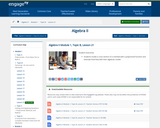
Students model a cross-section of a riverbed with a polynomial function and estimate fluid flow with their algebraic model.
- Subject:
- Math 3
- Mathematics
- Material Type:
- Lesson
- Author:
- EngageNY
- Date Added:
- 02/22/2020

Students model a cross-section of a riverbed with a polynomial function and estimate fluid flow with their algebraic model.

Students define rational expressions and write them in equivalent forms.
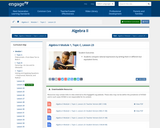
Students compare rational expressions by writing them in different but equivalent forms.
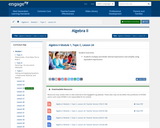
Students multiply and divide rational expressions and simplify using equivalent expressions.
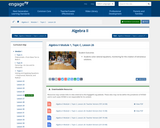
Students solve rational equations, monitoring for the creation of extraneous solutions.
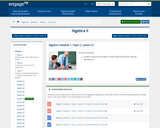
Students solve word problems using models that involve rational expressions.
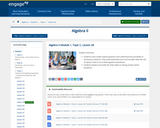
Students solve simple radical equations and understand the possibility of extraneous solutions. They understand that care must be taken with the role of square roots so as to avoid apparent paradoxes.
Students explain and justify the steps taken in solving simple radical equations.
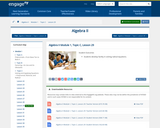
Students develop facility in solving radical equations.

Students define a complex number in the form a + bi, where a and b are real numbers and the imaginary unit i satisfies i 2 = −1. Students geometrically identify i as a multiplicand effecting a 90° counterclockwise rotation of the real number line. Students locate points corresponding to complex numbers in the complex plane.
Students understand complex numbers as a superset of the real numbers; i.e., a complex number a + bi is real when b = 0. Students learn that complex numbers share many similar properties of the real numbers: associative, commutative, distributive, addition/subtraction, multiplication, etc.
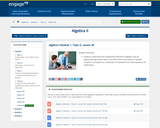
Students understand the Fundamental Theorem of Algebra; that all polynomial expressions factor into linear terms in the realm of complex numbers. Consequences, in particular, for quadratic and cubic equations are understood.
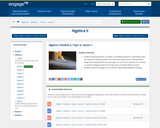
Students apply geometric concepts in modeling situations. Specifically, they find distances between points of a circle and a given line to represent the height above the ground of a passenger car on a Ferris wheel as it is rotated a number of degrees about the origin from an initial reference point.
Students sketch the graph of a nonlinear relationship between variables
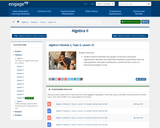
Students observe identities from graphs of sine and cosine basic trigonometric identities and relate those identities to periodicity, even and odd properties, intercepts, end behavior, and the fact that cosine is a horizontal translation of sine.
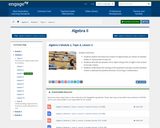
Students explore the historical context of trigonometry as motion of celestial bodies in a presumed circular arc.
Students describe the position of an object along a line of sight in the context of circular motion.
Students understand the naming of the quadrants and why counterclockwise motion is deemed the positive direction of turning in mathematics.

Students define the tangent function and understand the historic reason for its name.
Students use special triangles to determine geometrically the values of the tangent function for 30°, 45°, and 60°.

Students define the secant function and the co-functions in terms of points on the unit circle. They relate these names for these functions to the geometric relationships among lines, angles, and right triangles in a unit circle diagram.
Students use reciprocal relationships to relate the trigonometric functions and use these relationships to evaluate trigonometric functions for multiples of 30, 45, and 60 degrees.

Students graph the sine and cosine functions and analyze the shape of these curves.
For the sine and cosine functions, students sketch graphs showing key features, which include intercepts; intervals where the function is increasing, decreasing, positive, or negative; relative maxima and minima; symmetries; end behavior; and periodicity.
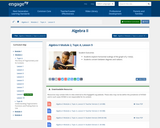
Students explore horizontal scalings of the graph of y =sin(x).
Students convert between degrees and radians.
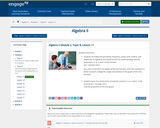
Students formalize the periodicity, frequency, phase shift, midline, and amplitude of a general sinusoidal function by understanding how the parameters A, w, h, and k in the formula
f(x) = Asin(w(x-h))+k
are used to transform the graph of the sine function, and how variations in these constants change the shape and position of the graph of the sine function.
Students learn the relationship among the constant A, w, h, and k in the formula f(x) = Asin(w(x-h))+k
and the properties of the sine graph.
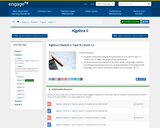
Students review how changing the parameters A, ω, h, and k in f(x) = A sin(ω(x - h)) + k affects the graph of the sine function.
Students examine the example of the Ferris wheel, using height, distance from the ground, period, and so on, to write a function of the height of the passenger cars in terms of the sine function: f(x) = A sin(ω(x - h)) + k.

Students graph the tangent function.
Students use the unit circle to express the values of the tangent function for π - x, π + x, and 2π - x in terms of tan(x), where x is any real number in the domain of the tangent function.